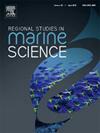鳍鱼养殖的空间适宜性分析——以突尼斯中东部沿海为例
IF 2.1
4区 环境科学与生态学
Q3 ECOLOGY
引用次数: 0
摘要
本文概述了一种基于空间多准则评价和数学模型(兼容性程度,DC)的海上网箱养殖场地选择方法。这种方法在筛选一级是有效的,即使在实地数据有限的地区,在那里明智的决策是至关重要的,或者在冲突地区,海洋空间规划是必不可少的。该案例研究是在突尼斯中东部海岸Monastir 's Bay进行的,中央政府计划在那里发展近海水产养殖活动。该方法包括两个步骤。首先,确定选择标准。利用22个因素评估笼址适宜性,包括物理特征、社会经济和环境条件。这些标准被划分为6个宏观标准:领域面积、流体力学、环境保护、污染预防、与现有沿海用途的相互作用和物流效率。使用GIS工具和多标准分析对所有标准进行空间分析。第二步,采用两种情景下的相容性评价模型,确定鱼类养殖最适宜区域。调查结果表明,该程序通过在现有活动设定的空间限制下,综合考虑水产养殖地点的适宜性和当地接收生态系统的保护情况,使选址成为可能。由于沿海地区的密集使用和不同用户之间的冲突,很少有非常适合的地点(高直流值)存在。这些较小的适宜区域应在更广泛的沿海活动范围内加以考虑。本研究可作为支持可持续水产养殖扩展和与基于生态系统的水产养殖方法相一致的选址方法的模型。本文章由计算机程序翻译,如有差异,请以英文原文为准。
Spatial suitability analysis for finfish aquaculture: A case study from center-east coast of Tunisia
This paper outlines a methodology for selecting offshore sites for finfish cage farming, based on Spatial Multi-Criteria Evaluation and mathematical model (Degree of compatibility, DC). This approach is effective at the screening level, even in areas with limited field data, where informed decision-making is critical, or in conflict zones where marine spatial planning becomes essential. The case study was conducted at the center-east coast of Tunisia, Monastir’s Bay, where the central government plans to develop offshore aquaculture activities. The methodology consists of two steps. First, selection criteria are identified. Twenty-two factors were used to assess cage site suitability, including physical characteristics, and socioeconomic, and environmental conditions. These criteria were spatialized and classified into six macro-criteria: domain areas, hydrodynamics, environmental conservation, pollution prevention, interaction with existing coastal uses, and logistic efficiency. All criteria were spatially analyzed using GIS tools and multi-criteria analysis. In the second step, a degree of compatibility assessment model under two scenarios was applied to establish the most suitable areas for finfish aquaculture. The findings show that the procedure enables site selection by integrating the suitability of a site for aquaculture purposes with the conservation of the local receiving ecosystem under spatial restrictions set by existing activities. Few highly suitable sites (high DC value) exist, primarily constrained by intensive coastal usage and conflicts among various users. These smaller areas of suitability should be considered within the broader context of coastal activities. This study serves as a model to support sustainable aquaculture expansion and site selection methodologies that align with ecosystem-based approaches to aquaculture.
求助全文
通过发布文献求助,成功后即可免费获取论文全文。
去求助
来源期刊

Regional Studies in Marine Science
Agricultural and Biological Sciences-Ecology, Evolution, Behavior and Systematics
CiteScore
3.90
自引率
4.80%
发文量
336
审稿时长
69 days
期刊介绍:
REGIONAL STUDIES IN MARINE SCIENCE will publish scientifically sound papers on regional aspects of maritime and marine resources in estuaries, coastal zones, continental shelf, the seas and oceans.
 求助内容:
求助内容: 应助结果提醒方式:
应助结果提醒方式:


